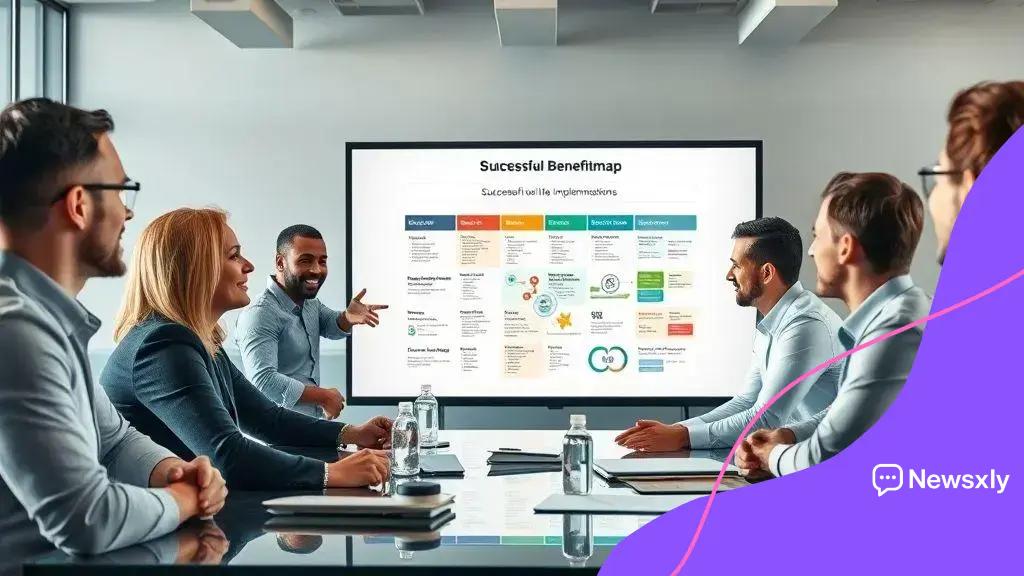Benefitmap: Uncovering the Hidden Advantages of Technology

Benefitmap is a strategic tool that enables organizations to visually map and prioritize the benefits of technology investments, improving decision-making and aligning tech initiatives with business objectives.
Benefitmap is changing the way we view technology’s role in our lives. Ever wondered how it could streamline your processes and open new opportunities? This article explores the many ways benefitmap can revolutionize your approach.
Understanding the concept of benefitmap
Understanding the concept of benefitmap is essential for anyone looking to leverage technology effectively. This innovative approach helps identify and visualize the specific benefits that technology can provide.
By utilizing benefitmap, businesses can clarify their objectives and align their technological investments with desired outcomes. It acts as a roadmap, guiding users through the complex landscape of technology to discover how it can serve their goals.
The core components of benefitmap
At its heart, benefitmap comprises several key elements that must be understood:
- Visualization: It allows for a clear representation of benefits.
- Alignment: Ensures that all technological tools support strategic goals.
- Prioritization: Identifies which benefits are most crucial to focus on.
- Feedback: Incorporates lessons learned from past implementations.
Moreover, benefitmap encourages open dialogue in organizations. By creating a visual framework, teams can easily communicate about the benefits they expect from various technologies. This clarity helps everyone stay on the same page, reducing confusion and enhancing collaboration.
Why is benefitmap important?
Implementing benefitmap can lead to more informed decision-making. By clearly outlining the potential advantages, teams can make better choices about which technologies to pursue. Understanding the impact of each tool and system helps organizations innovate successfully.
As more companies embrace technology, the need for a comprehensive strategy becomes even more pressing. Benefitmap serves as a powerful tool to navigate this evolving landscape, ensuring that any technological investment is grounded in clear expectations and measurable outcomes.
By grasping the concept of benefitmap, organizations can harness the full potential of their technological investments and drive growth effectively.
Key advantages of using benefitmap
There are several key advantages to using benefitmap that can significantly enhance decision-making and strategic planning. Understanding these benefits can empower organizations to leverage their technology more effectively.
One of the primary advantages of benefitmap is its ability to provide clarity. Businesses can visualize the potential benefits of different technologies, enabling them to see how each tool aligns with their goals. This clarity helps teams prioritize their efforts and allocate resources more effectively.
Enhanced Communication
Another major benefit is improved communication across various departments. With a shared benefitmap, everyone can understand what to expect from new technologies. This alignment minimizes misunderstandings and fosters collaboration.
- Fosters collaboration: Teams work together better when they understand the benefits.
- Speeds up the decision-making process: Clear visualizations streamline discussions.
- Decreases resistance to change: A well-crafted benefitmap addresses concerns and highlights advantages.
Additionally, benefitmap serves as a framework for accountability. As teams implement new technologies, having a clear visual guide allows for tracking progress against expected benefits. This accountability often leads to better adoption rates and overall satisfaction with new systems.
Informed Decision Making
Lastly, using benefitmap can lead to more informed and confident decisions. Organizations can weigh the pros and cons of each technology based on tangible expected benefits versus costs. This informed approach reduces the chances of making poor investments.
By leveraging the advantages of benefitmap, organizations can create a more strategic approach to technology implementation, ensuring that every choice is guided by clear insights and objectives.
Real-life examples of benefitmap success

Real-life examples of benefitmap success demonstrate how organizations can transform their operations. These stories provide insights into how the concept has been effectively applied in various contexts.
For instance, a mid-sized software company implemented benefitmap to align their technology strategies with business goals. By mapping out the anticipated benefits, they were able to prioritize projects that offered the highest return on investment. This approach not only improved productivity but also enhanced team collaboration.
A Case Study in Retail
Another notable example comes from the retail industry. A major retail chain adopted benefitmap to identify technology investments that would improve customer experience. By focusing on the benefits of integrating an omnichannel system, they successfully increased customer satisfaction and sales.
- Enhanced Customer Engagement: Customers could shop seamlessly across multiple platforms.
- Improved Inventory Management: The system reduced overstock and stockouts.
- Data-Driven Decisions: Insights from customer behavior shaped future marketing strategies.
This case highlights that benefitmap provides clarity in understanding customer needs, allowing companies to tailor their strategies. Companies can strategically implement technology that truly resonates with their audience.
Success in Healthcare
In the healthcare sector, a hospital network used benefitmap to streamline its operations. By identifying the expected outcomes of implementing electronic health records (EHR), they decreased paperwork errors significantly. More importantly, it improved patient care by providing immediate access to vital information.
The successful use of benefitmap in these examples shows that it is a powerful tool for driving strategic technology investments. Organizations that effectively map out expected benefits can better navigate challenges and maximize their resources.
How to implement benefitmap in your strategy
Implementing benefitmap in your strategy can significantly enhance how your organization integrates technology. This process involves a few clear steps that can make the implementation smooth and effective.
First, it is essential to gather a team that includes stakeholders from various departments. This diverse group can provide different perspectives on what benefits are most significant. By doing this, you ensure that the benefitmap reflects the needs of the entire organization.
Define Your Objectives
Next, you must define clear objectives for what you want to achieve with the benefitmap. Understanding your goals will guide the rest of the implementation process. Consider questions like:
- What challenges are we trying to solve?
- Which technology solutions align with our goals?
- What resources do we need?
Once you have established your goals, you can begin to identify and map out the specific benefits of each proposed technology. This step involves analyzing how these tools will impact your workflow and overall efficiency. Keep communication open among team members to refine the benefits as you go.
Create the Benefitmap Visualization
The next step is to create the actual benefitmap visualization. Use tools that allow for easy updates and modifications. Your visual representation should clearly illustrate the benefits, costs, and any dependencies associated with each technology.
After designing the benefitmap, present it to the entire organization. Engaging everyone will help in gaining buy-in and acceptance of the strategy. Continuous feedback is crucial, as this will ensure the benefitmap remains relevant and effective.
Finally, implement the technology solutions according to your benefitmap. Monitor the performance and outcomes regularly. This process allows for adjustments along the way, ensuring that you stay aligned with your original objectives.
Common challenges and solutions with benefitmap
Using benefitmap can lead to many benefits, but organizations often encounter challenges during its implementation. Understanding these challenges is crucial for developing effective solutions.
One common challenge is resistance to change within the organization. Employees may feel uncertain about new technologies or processes. To address this, it is important to communicate the benefits of benefitmap clearly. Involving team members early in the process can help in easing their concerns.
Unclear Objectives
Another issue can arise from unclear objectives. Without a well-defined goal, the benefitmap may not resonate with the team’s vision. Setting specific and measurable goals is vital. This involves engaging all stakeholders to ensure that everyone understands what is expected.
- Define clear success metrics: Establish what success looks like from the start.
- Regularly revisit objectives: Make adjustments as required and keep everyone informed.
- Encourage feedback: This information can provide insight into areas needing improvement.
Additionally, technical difficulties can pose significant challenges. Integrating new technologies with existing systems may lead to complications. To counter this, ensure that thorough planning is done before implementation, along with having a dedicated support team ready to assist during the transition.
Maintaining Engagement
Maintaining engagement throughout the process is essential. Teams can become distracted or discouraged if they do not see progress. Regular updates about the benefitmap and the benefits realized so far can keep motivation high. Celebrate small wins to reinforce acceptance and enthusiasm.
By proactively addressing these challenges and implementing effective strategies, organizations can maximize the potential of benefitmap and leverage technology to achieve their goals.
In summary, utilizing benefitmap effectively can transform how organizations leverage technology. By understanding its advantages and addressing potential challenges, businesses can make informed decisions that align with their goals. Engaging all team members throughout the process promotes clarity and collaboration, leading to successful technology integration. Ultimately, a well-implemented benefitmap can streamline operations and enhance overall productivity.
FAQ – Common Questions about Using Benefitmap
What is benefitmap?
Benefitmap is a strategic tool that helps organizations visualize and prioritize the benefits of technology investments.
How can benefitmap improve communication within my team?
By creating a clear visual representation of expected benefits, benefitmap fosters better understanding and collaboration among team members.
What should I do if my team resists implementing benefitmap?
Involve team members in the process early and communicate the benefits clearly to address their concerns and gain their support.
How do I ensure the success of my benefitmap implementation?
Define clear objectives, engage stakeholders, and continuously monitor progress to make necessary adjustments for optimal outcomes.





